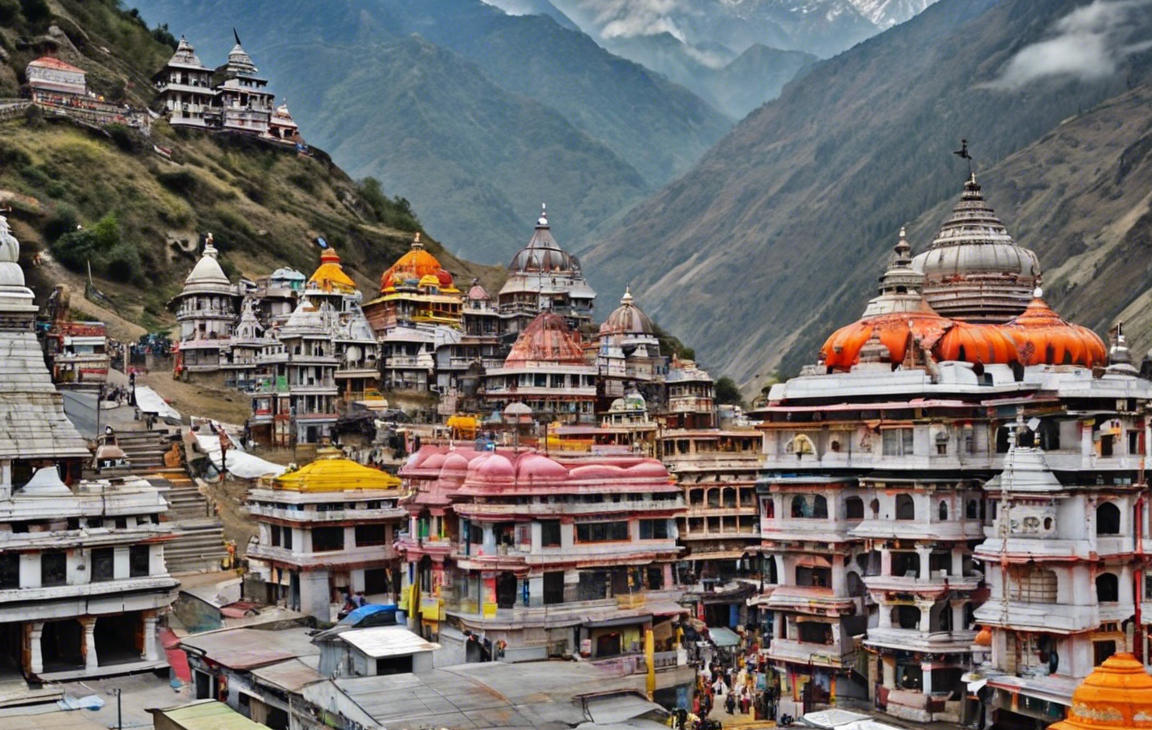Introduction
Char Dham Yatra is one of the most sacred pilgrimages for Hindus in India. It refers to the journey to four holy shrines located in the picturesque state of Uttarakhand in the Himalayas. The four dhams or abodes are Yamunotri, Gangotri, Kedarnath, and Badrinath. Each of these dhams holds immense religious significance and is believed to provide spiritual liberation to the devotees who undertake this journey. The Char Dham Yatra is not just a physical journey but a spiritual odyssey that is believed to cleanse the soul and purify one’s sins. In this comprehensive guide, we will explore the historical and religious significance of each of the dhams, the route of the yatra, important things to know before embarking on this sacred journey, and more.
The Four Dhams:
1. Yamunotri:
Yamunotri is the source of the Yamuna River and is dedicated to Goddess Yamuna. The temple at Yamunotri is nestled in the Garhwal Himalayas and is a 6 km trek from the town of Hanuman Chatti. The hot water spring at Janki Chatti is a popular stop for pilgrims on their way to Yamunotri.
2. Gangotri:
Gangotri is the source of the Ganges River and is dedicated to Goddess Ganga. It is located in the Uttarkashi district of Uttarakhand. The Gangotri temple holds great significance among Hindus, and the aarti performed at the temple is a sight to behold. The Bhagirathi River, a tributary of the Ganges, originates from Gangotri.
3. Kedarnath:
Kedarnath is dedicated to Lord Shiva and is one of the 12 Jyotirlingas in India. Situated near the Mandakini River, Kedarnath is known for its breathtaking natural beauty and the Kedarnath Temple that stands amidst snow-capped peaks. The temple is accessible via a trek from Gaurikund, and samadhi of Adi Shankaracharya is also located near the temple.
4. Badrinath:
Badrinath is dedicated to Lord Vishnu and is located along the banks of the Alaknanda River. The Badrinath Temple is one of the 108 Divya Desams dedicated to Lord Vishnu and holds immense religious significance. The temple is believed to have been established by Adi Shankaracharya and is a major pilgrimage site for Vaishnavites.
Route of the Yatra:
The traditional route for the Char Dham Yatra starts from Yamunotri and proceeds to Gangotri, Kedarnath, and finally Badrinath. Pilgrims usually start from the town of Rishikesh or Haridwar and travel to each of the dhams in a clockwise direction. The entire journey covers a distance of approximately 1500-1600 km and usually takes around 10-14 days to complete. The challenging terrain and high altitudes make the yatra physically demanding, requiring proper preparation and acclimatization.
Things to Know Before You Go:
1. Weather Conditions: The Char Dham region experiences extreme weather conditions with cold temperatures and occasional rainfall. It is essential to pack appropriate clothing and gear for the journey.
2. Medical Fitness: The yatra involves trekking at high altitudes, which can be strenuous. Ensure that you are physically fit and consult a doctor before undertaking the journey.
3. Accommodation: There are various accommodation options available along the yatra route, ranging from guesthouses to tents. It is advisable to book accommodations in advance during the peak pilgrimage season.
4. Travel Permits: Non-Indian nationals require inner line permits to visit certain areas along the yatra route. Make sure to obtain the necessary permits beforehand.
5. Respect Local Customs: The Char Dham region is deeply religious, and it is important to respect local customs and traditions. Dress modestly and refrain from littering.
FAQs:
1. Q: When is the best time to undertake the Char Dham Yatra?
A: The best time to undertake the yatra is during the summer months of May to June and the post-monsoon months of September to October. The dhams are usually closed during the winter due to heavy snowfall.
2. Q: Is the Char Dham Yatra suitable for senior citizens?
A: While the yatra is physically demanding, senior citizens can undertake the journey with proper preparation and medical guidance. Helicopter services are also available for those who are unable to trek.
3. Q: What are the transportation options available for the Char Dham Yatra?
A: Pilgrims can choose to travel by road or opt for helicopter services for certain stretches of the journey. Shared taxis and buses are commonly used for transportation.
4. Q: Are there any accommodation facilities available along the Char Dham Yatra route?
A: Yes, there are various accommodation options available along the yatra route, including guesthouses, ashrams, and tented accommodations. It is advisable to book in advance during the peak season.
5. Q: Can the Char Dham Yatra be undertaken solo?
A: While it is possible to undertake the yatra solo, it is recommended to travel with a group or a registered tour operator for safety and convenience.
Conclusion:
The Char Dham Yatra is not just a pilgrimage but an experience that encompasses faith, devotion, and nature’s splendor. It is a journey that tests one’s physical endurance and spiritual strength while offering moments of tranquility and divine connection. As pilgrims undertake this sacred journey, they not only seek blessings from the deities but also embark on a quest for self-discovery and inner peace amidst the majestic Himalayas. The Char Dham Yatra remains a timeless tradition that draws in millions of devotees from across the country and beyond, emphasizing the spiritual richness and cultural heritage of India.







